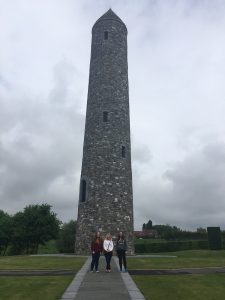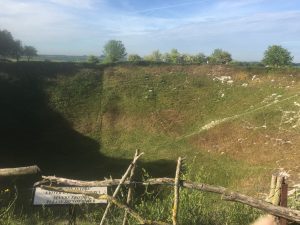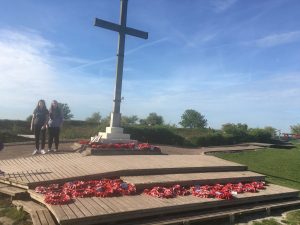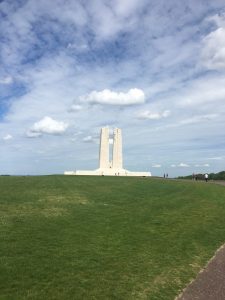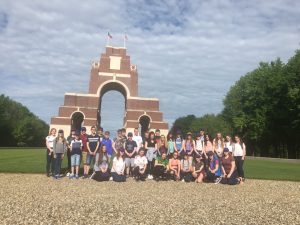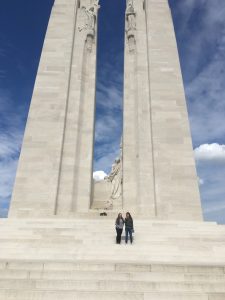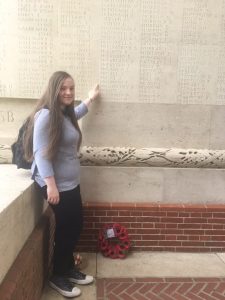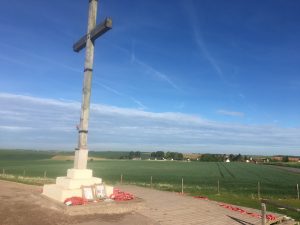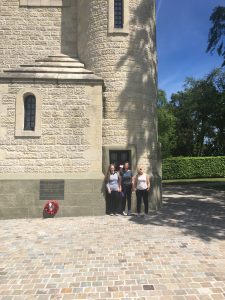Two Year 10 pupils from Limavady Grammar School, Caoimhe and Kate, accompanied by their History Teacher, Miss Wright, visited France 16 – 19 May 2017 as part of an Education Authority initiative to commemorate the centenary of the Great War. Pupils and teachers from 17 Northern Ireland schools travelled to the Somme region to tour the main battlefield sites and cemeteries, expertly guided by Tom Saunders from the Somme Association.
While the Battle of the Somme is often remembered for the huge losses on the first day (1 July 1916), the offensive continued until November 1916 – a total of 141 days – by which time more than 1 million Commonwealth, French and German soldiers had been wounded, captured, or killed. Some 150,000 Commonwealth servicemen lie buried in 250 military and 150 civilian cemeteries on the Somme. Six memorials to the missing commemorate by name more than 100,000 whose graves are not known.
After a trip across the Channel Tunnel, the group’s first stop was at the Canadian Memorial at Vimy Ridge. The Canadian government was granted land by France in 1922 to build a memorial to Canadian Forces who had served in France and Belgium. The position of the monument was agreed at the highest point of Vimy Ridge, a battlefield location where the Canadian Corps, suffering 10,602 casualties, succeeded in forcing the Germans out of their heavily entrenched positions in April 1917.
An early start was made on Day Two and the sun was blazing as the group arrived at the Lochnagar Crater. Named after a British trench, this is one of the largest craters ever made by man in anger. The Lochnagar mine was sprung at 7:28 a.m. on 1 July 1916 leaving a crater 30 m deep and 100 m wide with the explosion believed to have been heard in London.
A short distance away is the Thiepval Memorial and Ulster Tower. The Thiepval Memorial holds the names of the 72 246 missing British Empire servicemen who died in the Battle of the Somme, including Kate’s great, great, great uncle, Frank McGinniss (Royal Inniskilling Fusiliers), whose name Kate was able to locate on the wall. The Ulster Tower, a copy of Helen’s Tower, Newtownards, where the 36th Ulster Division trained, was one of the first memorials to be erected on the Western Front after the end of the war and commemorates the men of the 36th Division and all those from Ulster who served in the First World War. An emotional walk around Thiepval Wood gave everyone the opportunity to visualise the attack by these men on the first day of the Battle of the Somme, when 2 000 men of 36th Ulster Division lost their lives as they went over the top in an attempt to capture the Schwaben Redoubt. Many men still lie undiscovered, along with unexploded shells, in the depths of Thiepval Wood, now owned and preserved by the Somme Association.
One highlight of the trip was the attendance at the funeral of a soldier who died at the Somme in September 1916. The remains of 22 year old Private Henry Parker of the 5th Battalion Yorkshire Regiment were found where he had fallen in a field outside Arras. After forensic tests, the remains were identified and Private Parker’s family were invited to attend his reburial at Warlencourt British Cemetery. The school group were honoured to be invited to attend the very rare event of the full military funeral of a soldier who fought in the Great War.
Belgium, and the city of Ypres, was on the itinerary for Day Three and en route we stopped off at Tyne Cot Commonwealth War Graves Cemetery, the largest cemetery for Commonwealth forces in the world. Close by is the Langemark German Military Cemetery which began with a small group of German graves in 1915 and now is thought to hold remains of over 9 000 men. A few German soldiers are buried in the Commonwealth grave yards and these are quite easily found as they are always a little distance off from the graves of British servicemen.
Before heading into Ypres, the group were able to view the bunker where Major John McCrae worked as a medic and later penned the poem ‘Flanders Fields’ after witnessing death and burial of his good friend, Lt. Alexis Helmer who was killed in battle in May 1915. Later that evening, six pupils from the group were able to participate in a wreath laying ceremony at the Menin Gate in Ypres. Every evening at 8pm buglers from the local fire brigade sound the “Last Post” under the arches of the Gate. This ceremony has been carried on every evening since 2 July 1928, except during the occupation by the Germans in World War II, when the daily ceremony was conducted at a military Cemetery in England. The ceremony was resumed at the Menin Gate the very evening the town had been liberated by Polish forces in 1945.
By Friday, it was time to return home just as the weather changed, becoming overcast and showery. For most of the trip, the sunny, warm weather made it almost impossible to imagine the terror, death and anguish that soldiers must have experienced in 1916. Under the clear blue skies, it was hard to think of the mud, the rats and lice, and the constant bombardment of the shelling. With only birdsong breaking the silence of the cemeteries, it was difficult to comprehend the scale of the death and destruction. Yet the work of the Commonwealth War Graves Commission, set up to build and preserve memorials to those who died, helps all who visit the Somme to remember the human cost of the fighting.
Our highlights:
Miss Wright: ‘ I will always remember the cemetery where Willie McBride is buried – it’s small and secluded, tucked behind a wall and bordered by a beautiful cottage garden on one side and a field of friendly Charolais cattle on the other; it’s the perfect spot for a soldier from Ireland to rest’.
Kate: ‘ My favourite part of the trip was attending the funeral of Private Henry Parker because it was really interesting to see how much effort was put into remember soldiers who fought and died over 100 years ago. I loved seeing the soldiers in their uniforms and hearing the Last Post.’
Caoimhe: ‘ Visiting Thiepval Wood was a highlight for me because this is where many soldiers from the 36th Ulster Division fought and died on 1 July 1916. It was interesting to see original trenches which had been maintained and looked like they did during the war 100 years ago.’
